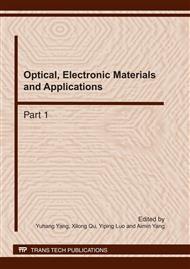p.773
p.777
p.782
p.787
p.793
p.798
p.804
p.809
p.814
Research on Magnet Excitation and Image Processing Used in Visual Detection
Abstract:
A novel visual detection set, which can detect sub-superficial defects in conductive specimens, is presented in this paper. The set has a laser source, a charge coupled device (CCD) camera, and a magnetic excitation. The linear polarized light given off by the laser source is modulated by the superimposition of the magnetic fields induced by the coil and eddy current, and acquired by the CCD. Given the exciting current is known and the eddy current is influenced by the defects, the information of defects can be extracted from the image acquired by CCD. The magnet excitation and image processing are described in detail. Experimental tests have been done and the method presented is proved by the experimental results.
Info:
Periodical:
Pages:
793-797
Citation:
Online since:
March 2011
Authors:
Keywords:
Price:
Сopyright:
© 2011 Trans Tech Publications Ltd. All Rights Reserved
Share:
Citation:


